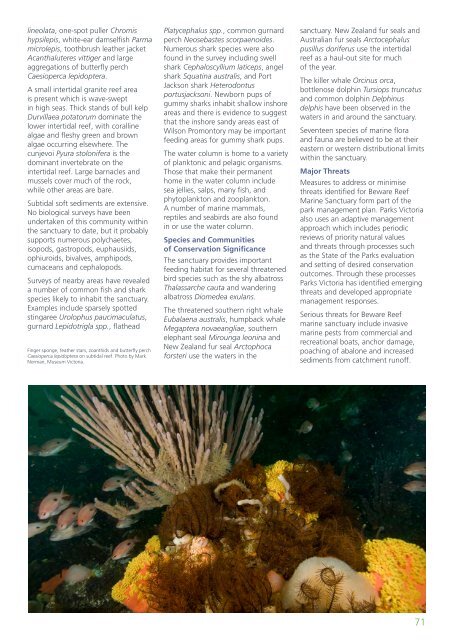Marine Natural Values Study Summary - Parks Victoria
Marine Natural Values Study Summary - Parks Victoria
Marine Natural Values Study Summary - Parks Victoria
You also want an ePaper? Increase the reach of your titles
YUMPU automatically turns print PDFs into web optimized ePapers that Google loves.
lineolata, one-spot puller Chromishypsilepis, white-ear damselfish Parmamicrolepis, toothbrush leather jacketAcanthaluteres vittiger and largeaggregations of butterfly perchCaesioperca lepidoptera.A small intertidal granite reef areais present which is wave-sweptin high seas. Thick stands of bull kelpDurvillaea potatorum dominate thelower intertidal reef, with corallinealgae and fleshy green and brownalgae occurring elsewhere. Thecunjevoi Pyura stolonifera is thedominant invertebrate on theintertidal reef. Large barnacles andmussels cover much of the rock,while other areas are bare.Subtidal soft sediments are extensive.No biological surveys have beenundertaken of this community withinthe sanctuary to date, but it probablysupports numerous polychaetes,isopods, gastropods, euphausiids,ophiuroids, bivalves, amphipods,cumaceans and cephalopods.Surveys of nearby areas have revealeda number of common fish and sharkspecies likely to inhabit the sanctuary.Examples include sparsely spottedstingaree Urolophus paucimaculatus,gurnard Lepidotrigla spp., flatheadFinger sponge, feather stars, zoanthids and butterfly perchCaesioperca lepidoptera on subtidal reef. Photo by MarkNorman, Museum <strong>Victoria</strong>.Platycephalus spp., common gurnardperch Neosebastes scorpaenoides.Numerous shark species were alsofound in the survey including swellshark Cephaloscyllium laticeps, angelshark Squatina australis, and PortJackson shark Heterodontusportusjacksoni. Newborn pups ofgummy sharks inhabit shallow inshoreareas and there is evidence to suggestthat the inshore sandy areas east ofWilson Promontory may be importantfeeding areas for gummy shark pups.The water column is home to a varietyof planktonic and pelagic organisms.Those that make their permanenthome in the water column includesea jellies, salps, many fish, andphytoplankton and zooplankton.A number of marine mammals,reptiles and seabirds are also foundin or use the water column.Species and Communitiesof Conservation SignificanceThe sanctuary provides importantfeeding habitat for several threatenedbird species such as the shy albatrossThalassarche cauta and wanderingalbatross Diomedea exulans.The threatened southern right whaleEubalaena australis, humpback whaleMegaptera novaeangliae, southernelephant seal Mirounga leonina andNew Zealand fur seal Arctophocaforsteri use the waters in thesanctuary. New Zealand fur seals andAustralian fur seals Arctocephaluspusillus doriferus use the intertidalreef as a haul-out site for muchof the year.The killer whale Orcinus orca,bottlenose dolphin Tursiops truncatusand common dolphin Delphinusdelphis have been observed in thewaters in and around the sanctuary.Seventeen species of marine floraand fauna are believed to be at theireastern or western distributional limitswithin the sanctuary.Major ThreatsMeasures to address or minimisethreats identified for Beware Reef<strong>Marine</strong> Sanctuary form part of thepark management plan. <strong>Parks</strong> <strong>Victoria</strong>also uses an adaptive managementapproach which includes periodicreviews of priority natural valuesand threats through processes suchas the State of the <strong>Parks</strong> evaluationand setting of desired conservationoutcomes. Through these processes<strong>Parks</strong> <strong>Victoria</strong> has identified emergingthreats and developed appropriatemanagement responses.Serious threats for Beware Reefmarine sanctuary include invasivemarine pests from commercial andrecreational boats, anchor damage,poaching of abalone and increasedsediments from catchment runoff.71
















